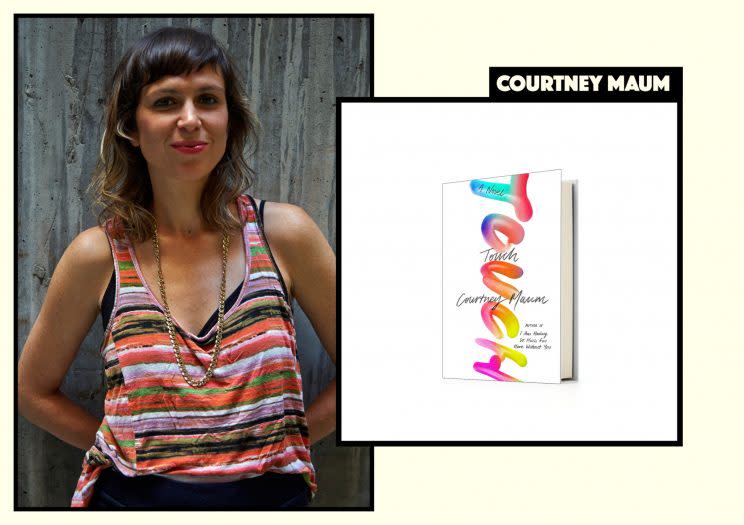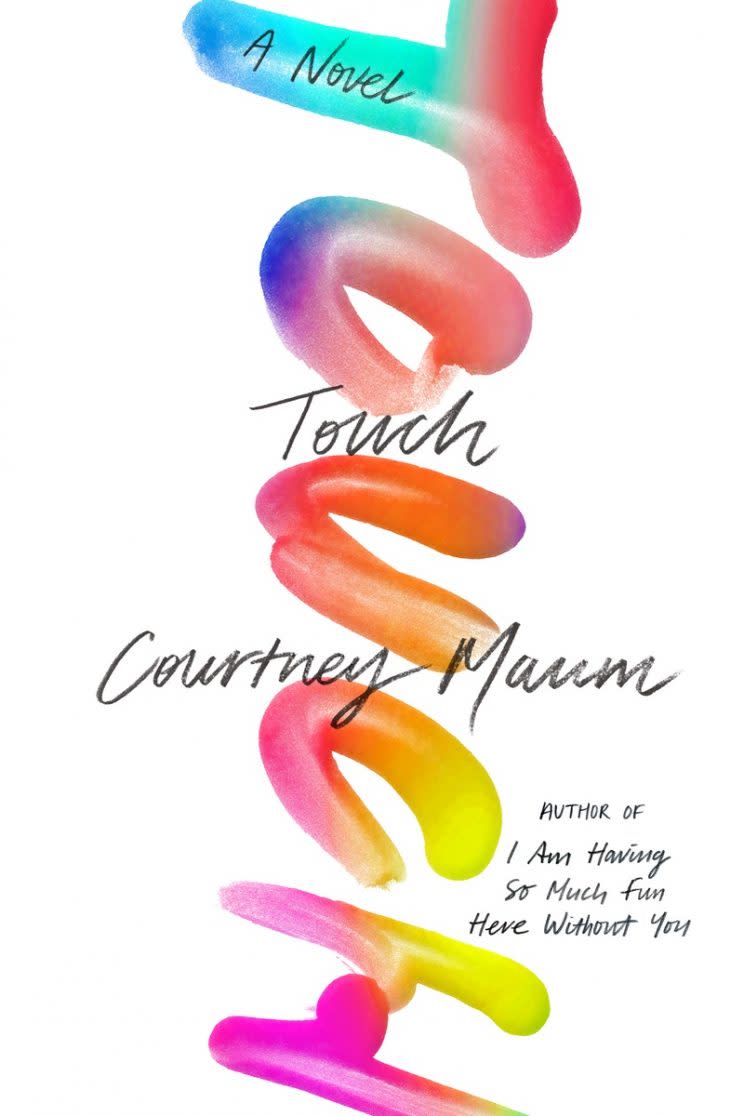'Touch' Author Courtney Maum on Trend Forecasting: 'It Comes Down to Instinct and Confidence'

In Courtney Maum’s new novel Touch — the follow-up to her 2015 I Am Having So Much Fun Here Without You — the world’s most powerful trend forecaster, Sloane Jacobsen, decides, to the chagrin of the major tech agency that just hired her, that society is ready to move away from screens and virtual interaction and back towards warm, old-fashioned human contact. It’s a movement that Maum, 38, of Connecticut, believes is happening IRL, too.
“I think we are moving back towards physical contact… Just actually sitting down in person, in-person-ism,” Maum tells Yahoo Beauty, which recently spoke to the writer about the state of modern interaction, along with her own past as a trend forecaster (Orange eye shadow and ear makeup? She called them both). Also discussed: her current life as mom to a 3-year-old and as a part-time color namer for companies including MAC Cosmetics. That’s not quite as romantic as it sounds, she says, noting that the task can involve “hundreds of pages” of “Excel spreadsheets.” Color us intrigued…
How did you become a trend forecaster?
I moved to France after college and got jobs through translation… including for Paris forecasting agency Nellie Rodi. I translated their trends books, these huge guides on everything from housewares and textures to makeup to really technical material like rubber, and because I was bilingual I would go to conferences, where I’d sell the books. [Eventually I worked] as a trend forecaster, specifically in the luxury beauty space, so I realized I had a talent for thinking and writing about beauty.
What is the skill set of a trend forecaster? In Touch, lead character Sloane gets a tingly feeling, almost like a premonition, when she’s forecasting. Is it something innate?
It absolutely comes down to instinct and confidence. I have a friend who does this now in Paris, and if you meet her, you just get that she has this aura of style and confidence but also real sensitivity. She’s a gentle, stylish person, and I think that’s what it comes down do: You have to be very bold to convince companies that such-and-such a thing is going to happen in a couple years, but you also have to have a sensitivity to always have your eyes and heart open to what is going on around you. So it’s a weird combination of being a very hard person but also a soft and porous person, as well.
What are some trend predictions you’ve right about?
I am so pleased to say I worked with a company about five years ago and I told them that “make-out mouth” was going to trend, that tangerine eye shadow was going to be a thing, and that ears were going to become the next hotspot for makeup. I’m delighted to see that it’s [all] finally happened. I keep waiting for the surfer zinc sunblock to join the makeup look — like bold lines, kind of tribal. I’m sort of surprised they haven’t come out with, like, a Chapstick [form of makeup] for the under-eye area.
In “Touch,” Sloan is childless by choice, and the “uber anti-mom.” You have a 3-year-old daughter. Were you a reluctant mom?
I was definitely someone who said I didn’t want kids, that kids weren’t necessary for me, that I was happy pursuing my artistic dreams. I thought that would be enough for me. It was actually my husband who lobbied for a kid. But I’m very happy to have a child! No one ever told me how fun it would be. And it sort of opened up a portal into a whole new variety of voices and characters I could access. Even with my first book, there was a child who was 9 years old. I was pregnant when I was writing it, but I still had to ask people, “Does this scene feel real?” I never babysat, I was never very fond of children. So it was hard for me to write from a parent’s point of view. I had to do outreach, and now I can use my own life! So yes, she’s a tax write-off. [Laughs]

At one point in the book, Sloane sees an alternative healer, even though it’s a stretch for her. How did you research this?
I’ve used it. My agent begged me to take that part out of the book! She said, “You’re going to sabotage your whole book with that scene.” But I was adamant about it. I lived in the Berkshires for almost nine years, [which is] pretty much the seat of alternative healing, and I tried reiki, reflexology. I wound up finding basically a shaman, and I have an energy healer, and I’ve done cord-cutting work with her. Reiki is a very powerful thing, and while it can sound ridiculous that you can be healed without actually being touched, don’t knock it till you try it. I’m one of these weirdos who can’t be massaged, so reiki is all I can handle. And I have a lot of friends who are alternative healers and who have energy therapists and things like that.
Reiki aside, though, you do actually see us, as a society, moving back towards touch, right?
Yes, because if there’s a silver lining from the election, it’s that people realize now how they’ve been completely in silos, living in these curated realities that we create with our smartphones — we read what we want, we stick to the opinions that we agree with. And so someone pulls the wool off your eyes and you’re like, “Oh! Actually not everyone agrees with me!” Having lived in Europe for a long time, I can say it really takes an American a lot to get out in the street, and the fact that Americans are now using their bodies and their voices and their free time to take to the streets, make calls, write letters — things like that signal to me that we’re still going to be using our smartphones as tools, but that the real force of change going forward is going to be face to face-ism… I really believe that very strongly, because it’s pretty much the only thing that truly works to bring about positive social change. You have to go back to these analog efforts to putting on shoes, holding up signs, using your actual hand and pen to write letters. So I think physical contact is already trending, actually.
Pen to paper… like thank-you notes maybe? Hopefully?
I think things like etiquette are also going to trend, because people are just so abominable now: They don’t respond to emails — forget it, if someone leaves a voice message — and people come stay a week in your house and don’t even leave you a bottle of wine. It’s astonishing. So I think that’s going to trend. People are going to get into stationery, maybe even sending calling cards? I could totally see that happening in Brooklyn, where people are leaving little calling cards to invite people to tea. Or birthday parties — [city moms will have] their kids mud wrestle or something, get really, really dirty. I can totally see that happening, taking their kids fishing or camping. Nature I think will trend, because of Trump trying to abolish national parks. Whenever something is threatened, it will often become cool.
OK so you’re also a freelance product and shade namer for, including for MAC cosmetics. Do they just send you a bunch of lipsticks and say, “Go”?
They never send me any actual tactile products. I get sent a brief with information about the product, photographs, and the key points they want to communicate through the name. Then I usually deliver hundreds of names, and the selection process is all in-house. It’s different with other companies, where we will sit around the table and talk about what works and what doesn’t. Then there’s the legal screening, where if you have 100, as many as 60 or 70 could drop out. It’s easy to start a company these days, so it’s becoming incredibly hard to name things… and now the L’Oreals and the Toyotas of the world will just buy up names within the category. So [for example] the Nissan Leaf — they’ll go and by up anything having to do with greenery and leaves and renewable technology, all those words. Whether or not they plan to use them, they own the trademarks. The automobile and beauty industries are the hardest to name, because dealing with companies like Proctor & Gamble? You can’t imagine what those Excel spreadsheets look like — hundreds of pages.
How do you brainstorm?
Depends on the industry and the creative brief. So if it’s a pharmaceutical company, I’ll probably be looking in a book of Latin or something, to look at prefixes and strange combos of Xs and Vs, because the sound is very cold. For a new hotel chain, I might just be looking out the window. [But after legal, and] by the third and fourth round I’ve got out the thesaurus, industry newspapers, Google translate — that’s when you really start translating things into languages you don’t even master to come up with original sounds.
What are your thoughts on “millennial pink”?
That’s awful, terrible sounding. Do millennials really want to be called millennials anymore? I just think that’s a terrible term. It just sounds cold, and I don’t want it on my face, I don’t want it. I actually like the shade. But I would not tell a furniture client, “Oh, we should come out with a couch in millennial pink!” We would call it Venice Rose.
Can you recall a color name you came up with that you were particularly fond of?
I can tell you something a client never used that I loved so much and thought was hysterical: It was for a hummus. They said it needs to sound really exotic, so “Dassit,” which I thought looked vaguely Turkish. But the insider joke, of course, was “Das it! That’s all you need!” But they never released the hummus. The space was too competitive.
Read more from Yahoo Beauty + Style:
Follow us on Instagram, Facebook, and Pinterest for nonstop inspiration delivered fresh to your feed, every day. For Twitter updates, follow @YahooStyle and @YahooBeauty.


